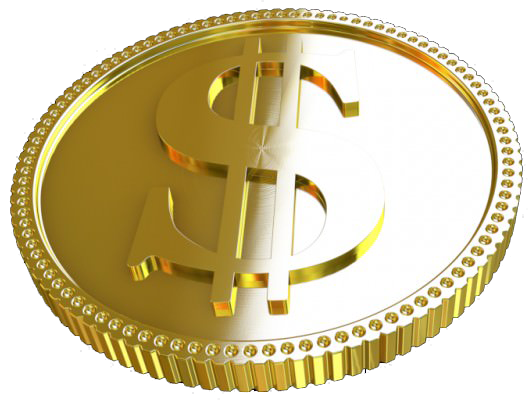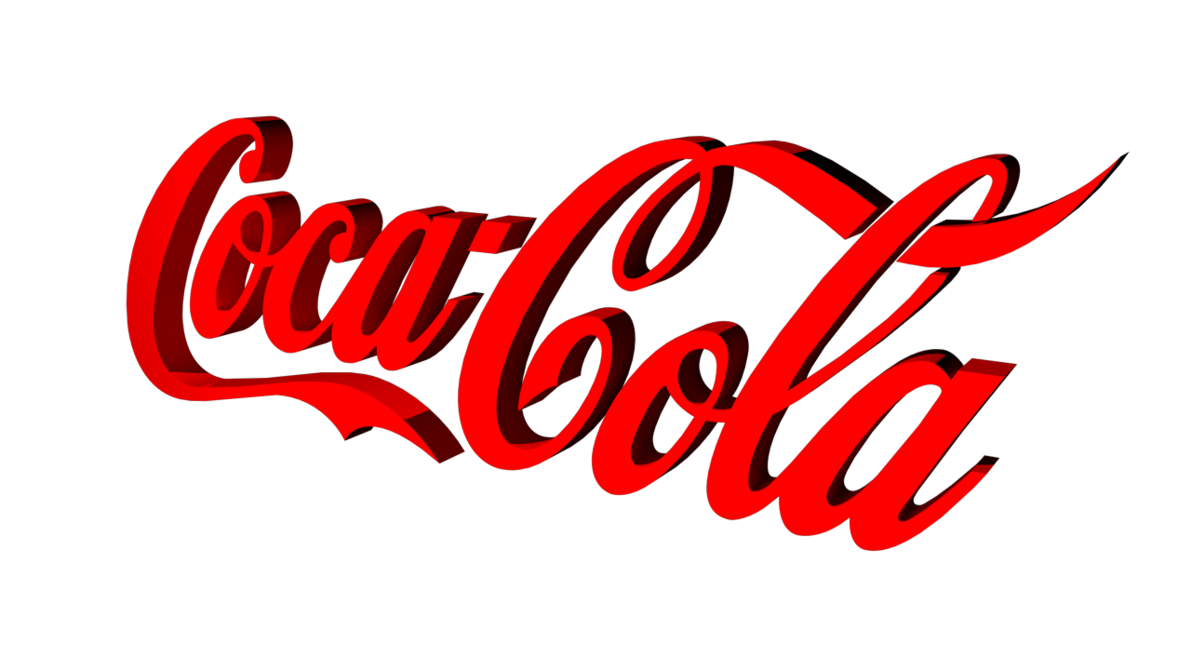Royal Academy of Art — The Hague 2018
Transcending Territories
Anna Lenczewska — 2017
Introduction
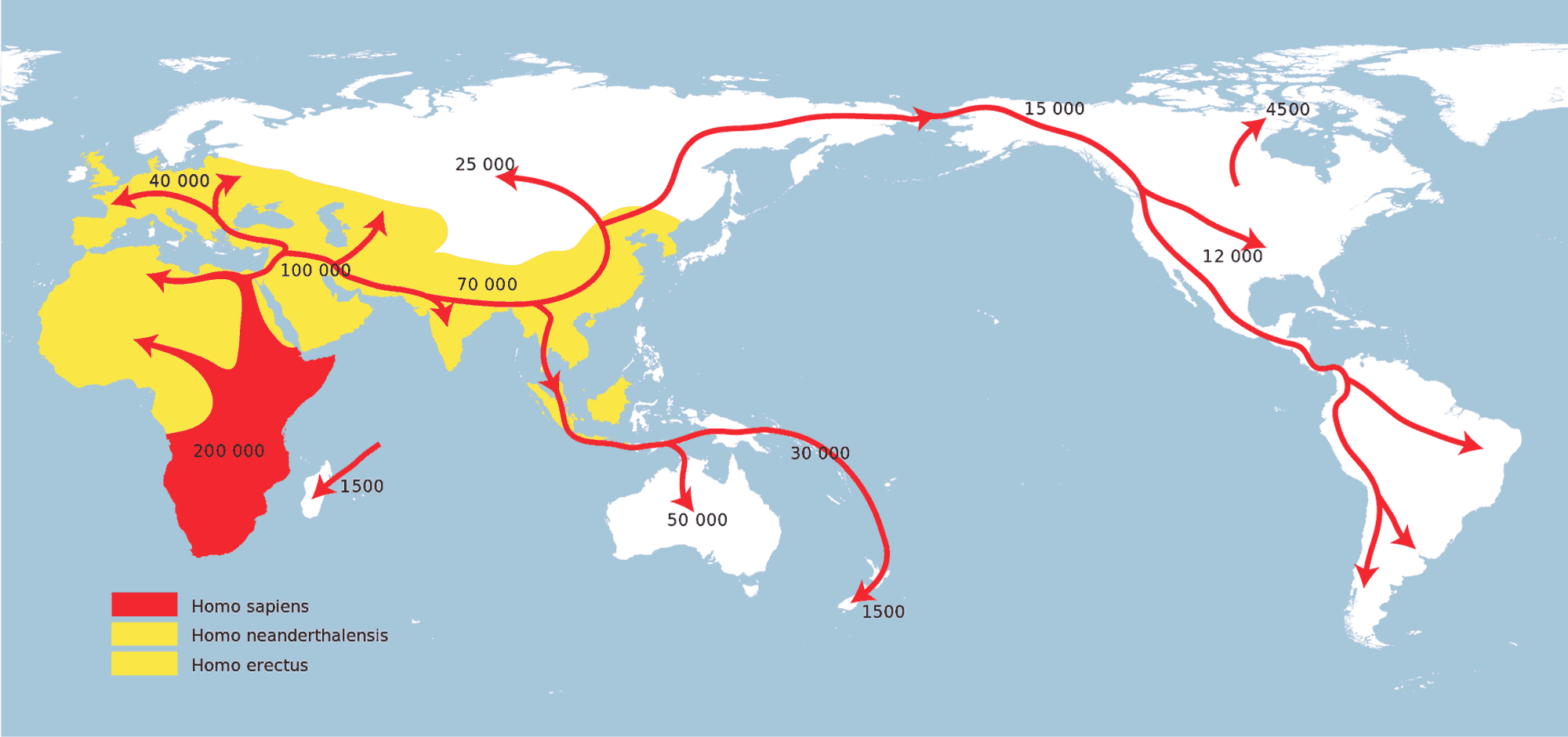 2015 has been called as the year of migrant crisis and people mass movement across Europe’s borders. It’s been 25th year of continent union between 26 states, which have made new Schengen system rules for easier traveling across, with no passport for all EU members. That action courage people to travel for higher employment, education, more wealth, better services, better climate, safer and less crime. I found this topic very interesting in aspect of artistic growth. I was wondering if people who create, and travel so easily, are being influenced by circumstances of the new environments which carries historical cultural and political values. To check this mechanism I researched various and known historical examples of people’s migration to analysis instruments responsible for those actions.
2015 has been called as the year of migrant crisis and people mass movement across Europe’s borders. It’s been 25th year of continent union between 26 states, which have made new Schengen system rules for easier traveling across, with no passport for all EU members. That action courage people to travel for higher employment, education, more wealth, better services, better climate, safer and less crime. I found this topic very interesting in aspect of artistic growth. I was wondering if people who create, and travel so easily, are being influenced by circumstances of the new environments which carries historical cultural and political values. To check this mechanism I researched various and known historical examples of people’s migration to analysis instruments responsible for those actions.
In the beginning, around 2 million years ago, homo sapiens started his migration from Africa to Asia, Europe and America. Within time, he and she began settling in satisfying them areas and started marking and protecting their land. That could be the first time when land became territory, and this is the very first primitive and political form of ownership over the land. Land, which is a solid part of the earth surface, not covered by the water, contain nature composition like, mineral deposits, forests, fish stocks, atmospheric quality. It is an area with specific boundaries which transformed to a territory, becomes a geographic assigned area with applied set of rules or laws, govern by later called administrative subdivision or authority.
Territory unifies people with common religion, tradition, habits, responsibilities, work, culture or way of spending time together. That factor involves group of people to interaction, by sharing same geographical territory, political authority, dominant cultural expectations what grows importance of the ground areas. Can I call it society, then? When I type ‘society’ in the most known browsers, I read that society is a group of people living together in an own way ordered community. Society in opinion of French philosopher and sociologist Pierre Bourdieu, shares dynamics between groups of people and people themselves. It is a multidimensional sphere, which contains number of sub-spaces, fields and forms. ‘Society' is a group, composed from the individuals, lives among others and in relation to others.
Cartography

While connecting in the strong groups of people progressed, for some of them, it was a survival need to migrate after animals for food reasons or seek for better climate for fertility and fruitful land. Better environmental conditions improved settlement, culture and knowledge along with interest for exploration of unknown lands. Navigation tool was mandatory to remember the rout back home and to pass it to younger generations. In earlier traditions people have been using non-visual and non -representational methods such as oral ways to pass information, later by using ‘stars constellation’ reading, it was easier to navigate their travels and project their geographical positions which were memorialised on the cave walls for later generations. Making maps served to possibly provide routs to different beneficial sources but could also avoid unwanted danger. Cave paintings and rock carvings used simple visual elements that may have aided in recognising landscape features, such as hills or dwellings, mountains, rivers, valleys and routes.
One of the oldest discovered maps in the world is dated for around 7th century BCE. Cartography, the study and practice of making maps, has been an integral part of the human history for thousands of years. One of the first and the oldest examples are represented on cave paintings and then ancient maps, like maps of Babylon, Greece, and Asia. When Romans imperium started expanding mapmakers drew a land areas that no one had explored yet, they often labeled it as “Terra Incognita”— “Unknown Territory"—as the term continued to be used for centuries afterward, Columbus and his successors first crossed the Atlantic, they entered upon “Terra Incognita”, a land that came to be called the “New World” when it used to mean an unexplored or unfamiliar territory. Through the Age of Exploration, people have created and used maps as essential tool to help them define, explain, and navigate their way through the world. Maps became two-dimensional drawings, sometimes with adaptation of three-dimensional shapes, globes, models stored in purely numerical forms.
1
Unfortunately Cartography has also a dark side of its use. Communication and transport development was influential on social group boundaries and people new ways of unification. It helped to standardise languages through time and space, making larger groups of people share same language and the awareness of common language. Factors such as formations of modern factories, modern schools, the railways played important role in shaping public culture and knowledge, but in western world map projection became a powerful political tool to categorise people and lands, what brought deeply changing way of thinking for centuries. 1 2
 A map projection is one of many methods used to represent surface of the earth or other round body. This process is typically, but not necessarily, a mathematical procedure but some of the methods are graphically based.
Choosing a projection surface, it can be transformed onto another surface without stretching, tearing, or shrinking because it should be an applicable surface. The spheroid or ellipsoid are not applicable with a plane surface like flat sheet, because it will always distort the image- the easies way to understand this example is to similar the impossibility of making a flat sheet from an orange peel.
A map projection is one of many methods used to represent surface of the earth or other round body. This process is typically, but not necessarily, a mathematical procedure but some of the methods are graphically based.
Choosing a projection surface, it can be transformed onto another surface without stretching, tearing, or shrinking because it should be an applicable surface. The spheroid or ellipsoid are not applicable with a plane surface like flat sheet, because it will always distort the image- the easies way to understand this example is to similar the impossibility of making a flat sheet from an orange peel.
The globe is the only way to represent the earth without distortion. Globes have the advantage of being true to metric properties and able to provide a true picture of spatial relationships on the earth’s surface. The disadvantages are that it is impractical to make large-scale maps with it, it is difficult to measure on a globe, one can’t see the whole world at once. The flat map has the disadvantage of always distorting one or more of the metric properties and it is more difficult to get a true picture of the spatial relationships between objects also they have numerous advantages. It’s not really practical to make large or even medium scale globes, it is easier to measure on a flat map, easy to carry around and you can see entire world at once.
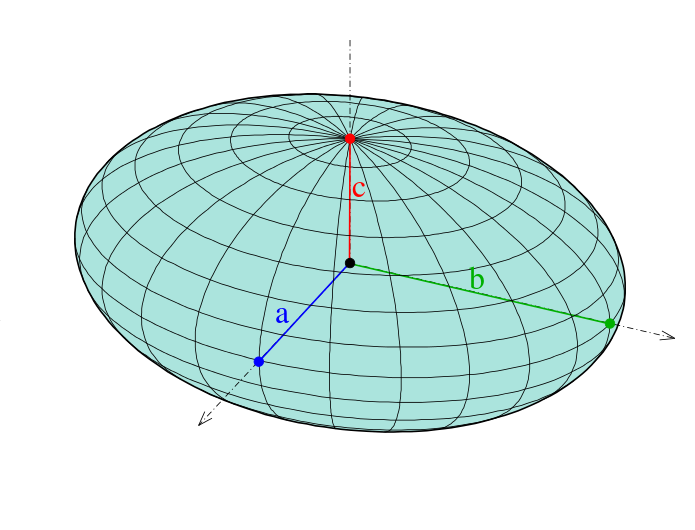 Mercator projection, was a type of map introduced in 1569 by Gerardus Mercator. It is a world map which for almost 500 years has been one of the most popular projections in use, but it has been designed as navigation tool for European sailors during the Western European expansion around the world… Straight lines distorted scale, made easier ways to cross the ocean, and presented false sizes of locations, nations and continents influenced on how size equate with importance and power.
Arno Peters, had criticised Mercator’s projection in 1973 by saying, “It over-values the white man and distorts the picture of the world to the advantage of the colonial masters of the time.” European imperialist attitudes for centuries created an “ethical bias” for “western civilisation” against the developing world. So as Ruben Pater said “The graphic nature of maps simplifies reality, giving makers and users a sense of power without social and ecological responsibilities”, Pater theorise that, in the colonial days, maps not only provided means for navigation, but also legitimised the territorial conquests.
3
4
5
6
7
8
9
10
11
12
13
14
15
16
Mercator projection, was a type of map introduced in 1569 by Gerardus Mercator. It is a world map which for almost 500 years has been one of the most popular projections in use, but it has been designed as navigation tool for European sailors during the Western European expansion around the world… Straight lines distorted scale, made easier ways to cross the ocean, and presented false sizes of locations, nations and continents influenced on how size equate with importance and power.
Arno Peters, had criticised Mercator’s projection in 1973 by saying, “It over-values the white man and distorts the picture of the world to the advantage of the colonial masters of the time.” European imperialist attitudes for centuries created an “ethical bias” for “western civilisation” against the developing world. So as Ruben Pater said “The graphic nature of maps simplifies reality, giving makers and users a sense of power without social and ecological responsibilities”, Pater theorise that, in the colonial days, maps not only provided means for navigation, but also legitimised the territorial conquests.
3
4
5
6
7
8
9
10
11
12
13
14
15
16
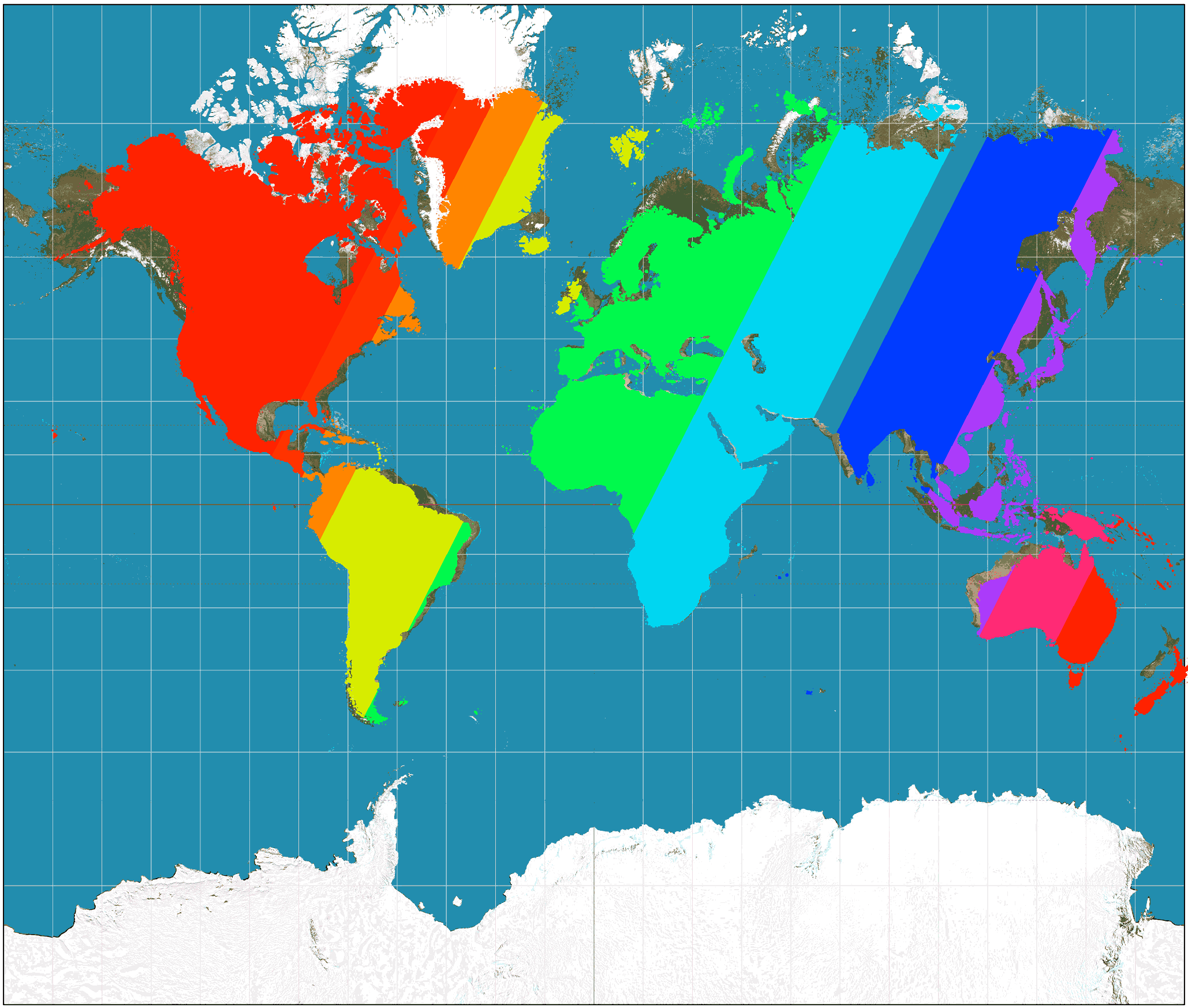
Culture
Do the past actions influence our culture? What are the factors? With colonialism and imperialism theme, European culture, as a progressive and expanding machine which caused so much of turmoil and humans suffer for past actions, is still carrying negative traits received through the time. (Michel Foucault, 1966) Such as all bad habits which have never been truly over seem to recur regularly. Nationalism, xenophobia and racism creates an arrogant assumption of Europe being in the centre of the world making all non-europeans as pejorative ’others’. Creating at the same time “European citizen as a prototype of a civilised human being.” 17
Raymond Williams in “Culture is ordinary” 1958, once said: “agriculture replaced by modern and organised industrial state influenced our natural human responses, making art and literature sweeping into the centres of power.” “The idea of national culture becomes an arena of thinking about the problem of ordinary culture within societies where local, national and global meanings circulate and collide.“
Williams metaphorically transforms experience of living across local, national and global borders to articulate sense of culture. He talks about nature of a culture, seen through individual minds and societies. Through factors such as experience, contact, discovery, and learning of the same shapes, purposes and meanings, observation and communication, what is directed by society common meanings and directions, underlining culture as a always traditional and creative. Pointing culture as an ordinary in every society and in every mind for way of life, for meaning the arts and learning,(the special process of discovery and creative effort. ) “Every human society has its own shapes own purposes and own meanings. Every human society expresses these, in institutions and in arts and learning.” 18 19
Culture is ubiquitous, what makes people feeling and thinking about it as about something very natural what makes them forget about that they actual dealing with it. “Culture is ordinary in every society and in every mind” as ordinary as people are and work is. Culture is a whole way of life, and the arts are part of a social organisation which economic change clearly radically affects. Culture is a way of life, with great importance of neighbourhood, mutual obligations, and common betterment as its expressed in the great working-class political and industrial institutions. Marxists always pointed, there is relationship between culture and production. If Art is a form of Cultural awareness - perspective of diversity and complexity, then there is a clear relation between art and experience because culture has social dimension. “Culture is a socially shared reservoir or repertoire of signs”. 20 21 22
Ruben Pater refers to “Practice of Looking”, saying that Design cannot be disconnected from the values and assumptions it was created, and from the ideologies behind it. Later he is concluding that just few decades ago, just before the age of interconnected people, the visual communication was contained within cities or countries. Pater postulate, that the visual communication nowadays became more ‘universal’ or ‘objective’ because of the network society, that people are part of, making information exchange across the planet creating miscommunication because of the culture differences. (”Something that was meant to be funny can incite violent protests the same day on the other side of the world.” ) making link at the same time to the Modernist design principles which western design education carries what underlines objectivity and universality. Cultural complexity could be categorised by regions, countries, races or religions but nowadays societies becoming culturally more diverse.
Visual communication across cultures deals with ability to read and understand images called visual literacy, which is influenced and trained through people experience, of how many images they have seen, and they cultural background. If cultures makes people different it’s obvious that it makes them also read images differently, because when individual enters the society he enters the field which has own habitat, it can be Economic, social or cultural what terminate certain settings, for example how to behave. It grows up from Society foundation made of political culture, economic culture, educational culture. 23
But what if nowadays we live in times of rootless and constant displacement. Variety of migration and mobility defines what kind of people build todays societies. Is it the key to the contemporary culture and the visual arts? [e.x. Institutions, work place] How social differentiation across social classes can be seen and understand in cultural practices, if people behave culturally according to social formed dispositions. [La Distinction(1979)] P.B. places individuals in socio-historic context, in a way that individual is shaped by its own biography and it’s impetus for any work, physical and mental.
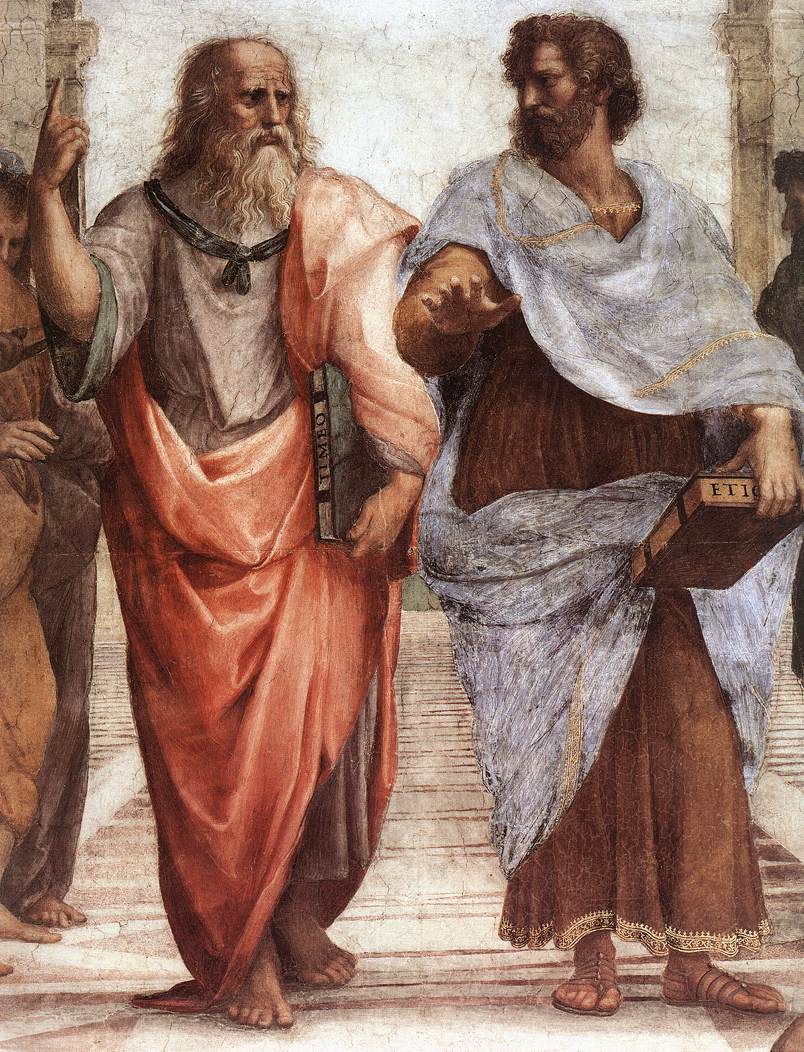
Todays world of flexibility and migration puts artists into the action of organising themselves, developing and structuring their autonomy. Artists create and share their work, entering public spheres, forming out of social ,political, economical and ecological landscape, presenting where do they stand, where the others stand, what do the artist wants, and what the others want. Need of flexibility and mobility is also a norm dictated by labor market. Permanent employments has exchanged with freelance temporary projects, repress economically artists.[Bourdieu,1977,1992] Individuality, mobility and self determination has strong meaning of free private individual, which constitutes liberal convention. Artists like to highlight their mobility because of ideal of individualism and their independence to market and state. 24
Artists Mobility. Artists and Nomads.
"Artistic autonomy is only possible when it is collectively supported.” Pascal Gielen refers artist creativity and migrating into auto-mobility. Structuring idea of a Car, as an ‘artist private atmosphere’, for who it wouldn’t be possible to manage the distance without entire network of motorways, occasional petrol stations or tire centres. In other words, the driver- artist, wouldn’t be able to continue driving without others. He is fully depending on them. In his opinion every artists must sojourn at regular times to stay inspired and stay alive, while places have stayed the same over the decades and roads connecting them became difficult to drive over, everything is changing, patrol stations, tire centres, road builders, so we must also change depending on circumstances.
It brings me an idea of Nomad model way of living. Are the europeans becoming culturally ’nomadic’ in already existing transcultural identity nowadays? (Braidotti, 1994; 20023; 2011b) In my opinion people became modern nomads, who live in different locations, moving from one place to another for various reasons, it could be political,economical,educational.. As an example of political mobility, ubiquitous refugee crisis is one of it. As economical I would call for big population of Indians, Polish or Pakistan community, coming to England after European Union have opened boundaries. As educational, I would use Erasmus program which makes studying and education abroad more accessible. Modern world is a world of interconnection. People independently, autonomously and irregardless travel from one end of the world to another. 25
Philosophy, sociology and economy
In my theory, I wonder how modern way of living influences artists creativity and abilities, how do they organise themselves if we live in world of mobility and flexibility. I detected, theory and practice of contemporary artists development through territory and circumstances that could change and influence them through economy, working modalities, social and political conditions. I could call concept of post-fordist way of working as an idea of flexibility, mobility, project-based, and temporary conditions that are happening now. I believe artists who wants to stay autonomous they have to build structures, especially in times when structures, transform from liberal to Neo liberal, from Fordism to Post-Fordism and from modern to contemporary. With no doubts there is strong connection between economy and society thats why I decided to have a closer look on economic theorists who are also a founders of sociology, whose theories deeply intertwined between people, economy and politics.
Economic theories
John Locke who is considered as the godfather of liberal political thought, wrote among other ideas that each person has a natural right to life, liberty, and property. Back then, this philosophical movement has been representing a classical liberalism which holds the most important value of individual liberty, which promoted priority to maximise individual freedom, by restricting the use of force and government in order to achieve this. Revolutionary way of thinking during the enlightenment period gave first light of liberalism and entire spirit of these actions to defend the “common good”, where political and economic system progressed social group as a “whole” and not benefitting a certain portion of individuals. Back then Locke’s Economic theory intertwined with political theory. However liberalism transformed from an individualistic philosophy to one that is more communal, taking zoom onto economics, maximising social progress for the group as a whole, and not benefitting a certain portion of individuals, increasing the role of private sector in the economy and society. Taking principals of classical liberalism and developing them with awareness of not repeating economic failures, promoting market economy under the guidance and rules of strong states, creating social market economy.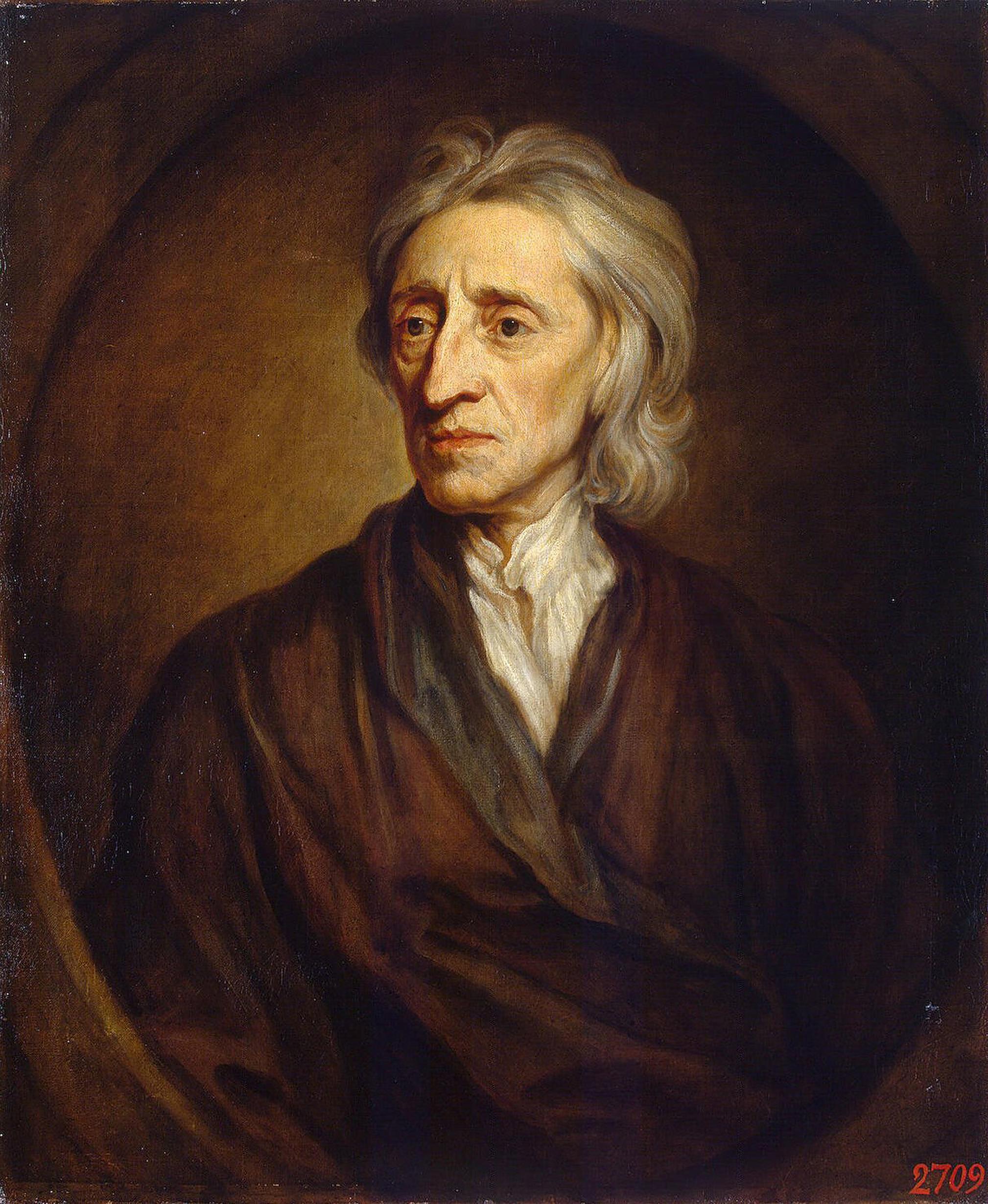
J.L was an English man living between 1632-1704, right before an industrial revolution, his world was a small scale manufacturers, who benefit from things found in nature and developed as private property out of it. Locke lived in time and world where farmer was a fee holder and what he produced became his private property and he could sell those goods to the public. When from the other side we have Karl Marx (1818-1883), a man who was living in totally different world than Locke’s world, because he has been living in the industrial revolution which made changes into the world that Locke’s world never knew. Agriculture mechanisation which happened, didn’t need people as much as before so they had to go to the cities to search for work in factories. Then we go on, to the large-scale manufacturing power, which replaced small-sale artisans, because produced goods could be generate more quickly, cheaply and greater volume. So this situation formed phenomenon of people who were not producing for themselves anymore a swell as they couldn’t keep that private property they produced. Workers were producing for somebody else-owners of building properties who owned the mills and factories. Concluding development of technology especially steam power shows us a standard view of capitalistic system which Karl Marx was strongly against to, and he’s seen it as a great labor exploitation, because if you are no longer producing for yourself - if you producing for another, how the one gets paid? In belief of K.M. work can be one of the sources of people greatest joys, but workers have to see themselves in objects they have been created. In his opinion ,if wage paid for workers labor was not carrying a true value of what their produce that made labourer alienated from one’s own labor. So people were disconnected and not motivated to the work anymore what created a distance between people and work because of the feeling of being used.Because of K.M. negative strong feeling towards capitalism he wrote some few thoughts about socialistic ideology, a better utopian economic system which would be more ethical that wouldn’t harm working people. Comunism is a radical version of socialism

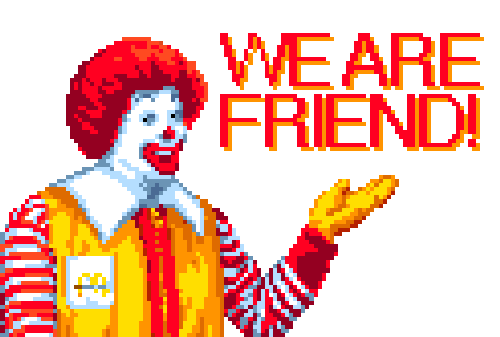

Polish Posters
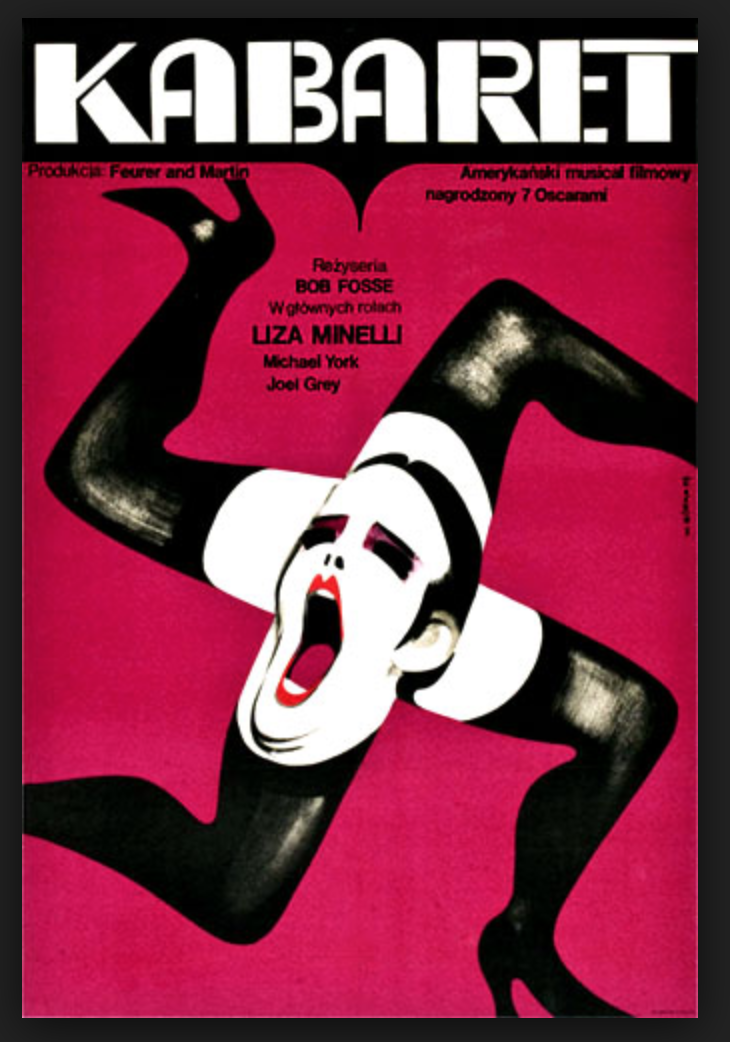
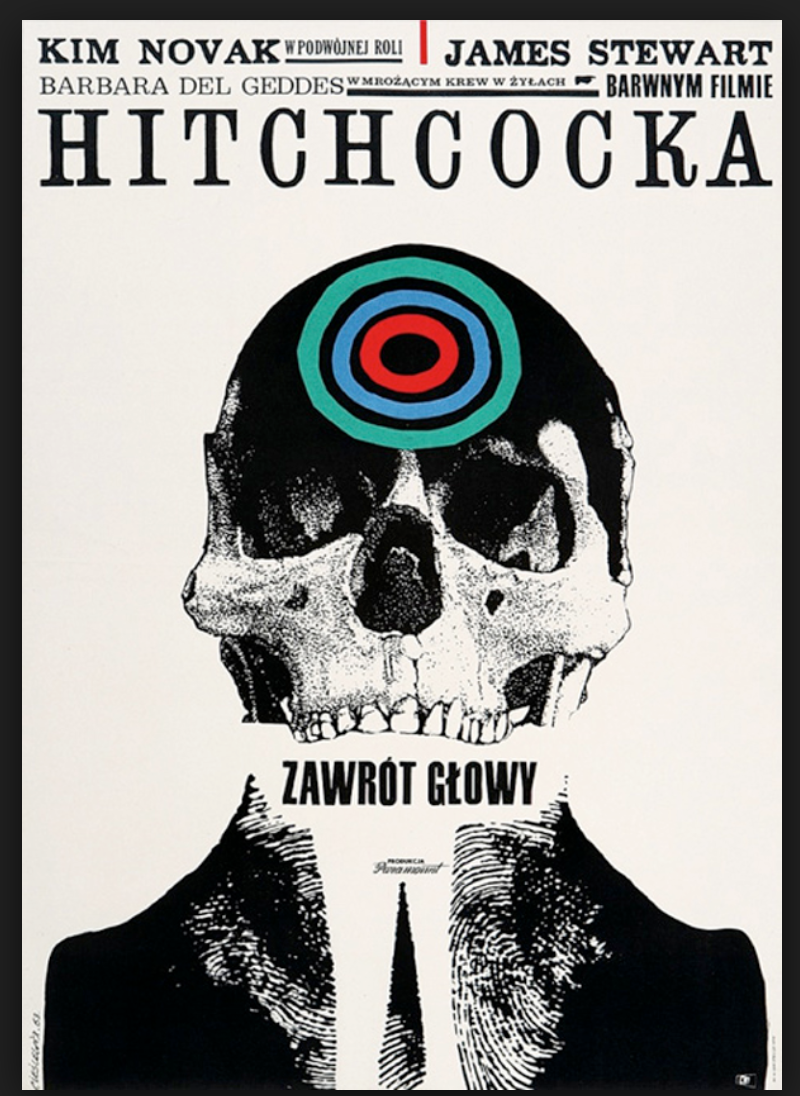
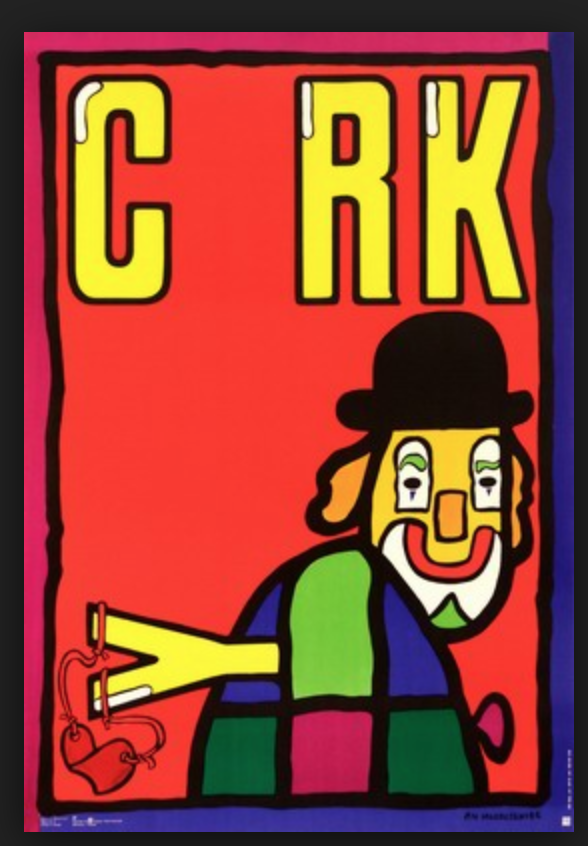
From my perspective because I’m Polish, what I’ve learned from art school, and the knowledge I’ve received during education in art college and later at the art academy is to reveal my emotional involvement with the subject which is most of the times very strong, my interests of commentary on society and use of symbolism. I learned to play with hidden meaning because work shouldn’t be only viewed but also should be read, pondered and digested.
Portuguese posters
After 2007, when European Economic Crisis was crushing collapsing every EU country bit by bit, Portuguese economic loss and resulting suffer related to deep recession and rising unemployment, heavily reflected on the society.
Happening already catastrophe of dropping GDP (Gross Domestic Product), falling down drastically, and austerity measures which progressed Portuguese unemployment rate what boosted one of the fastest rates in the EU, continued to assembled protesting residents and concerns of relatively new Portuguese democracy, what could be threatened by the spectre of mass-unemployment.


Following the crisis, abandoned buildings, old markets, and dilapidated areas of the city that are evidence of the hard times has struggled through. Portuguese citizens are unable to finance preservation of the buildings and legally forbidden from demolishing their properties. Many people were forced to look on impoverishing buildings crumble bit by bit what for instance gave nearly one in five buildings in central Porto vacant. Developers who can afford buying those houses, starts renovating them, to turn them back to the tourist rental market what makes it less possible to rent for longer time period what I assume goes together with high rent which locals cannot afford, so they are pushed away to the suburbs where newer buildings are cheaper. Difficult economics during period of past 20 years made city’s lost of over 80,000 permanent residents.

By coming to Portugal you can feel and see really strong connection between art and peoples attitude about their life condition and politics. Deformed creatures, faces and objects illustrated on street posters made me thinking of people anger, disappointment or fear but they are beautiful sometimes melancholic and sometimes funny too. In response to the situation, people pursued austerity.
Style visible on Porto’s streets express the meaning of emotional experience and physical reality influencing on them. Self-made and low budget production of posters I saw on the street walls, together with endless graffiti and illustrative political satyric murals brought the thought about individual perspective characterised by people’s reaction to what politically and economically was influencing them. It also associates to their expression dynamic’s of painting as perception and complex psychic structure which is showing Impressions and mental images.

35 36 37
On Porto’s city streets you can see confidence in illustration and bright colour use, way of expression and energetic and charismatic drawing or painting. The eager to be politically involved rises in a way of expressing opinion or criticism about certain issues. In my opinion posters and painting you see on the streets shows enormous expression of people frustration but plenty of humour too.
I consider the experiences and artists ways of working as a basis action factors, and government is as important as friendships, equality, universality, collaboration, presence and production. Loneliness and collaboration is always a decision but I think by collaborating, people may occur gift of creating conditions for an encounter, discussion, and sense and seriousness. Pascal Glen in “Mobile Autonomy”writes about place where arts has developed its domestic interior and artists metaphorically drives through roads, motorways and landscapes which he builds up from using social, political ,economical and ecological examples. Concluding public sphere also as a part of the landscape which is created from individuality, mobility and self-determination. Driver in that sense is heavily dependent on oil prices, contraction of motorways and range of governmental regulations. Gilen highlights important aspect of the car itself. Petrol stations, tire centres, road builders and traffic regulator influences which road driver might take, a swell as time passes and needs grows and completely different vehicles are build nowadays.
To stay mobile driver has to use different petrol stations ,service centres, and resting places to stay in game. If a driver would get stuck in one place he would lose auto-mobility, what means autonomy and artistic mobility. So due reading Gielen conclusions you might assume are that there is no autonomy without heteronomy.
In Europe during sixties there was observed the rise of dignified working conditions ,students translated dignity into respect for authenticity, creativity and demand for flexible or part time work. In the Eighties, the corporate world embraced these demands, neatly tailoring them to their own needs. From now on, post -Fordism was born and flexible labour was the norm, preferably on a freelance basis.
Rise of low-cost airlines in the early 1990s made artists traveling easier by plane than by car so it became easier to keep updated with international art scene. From biennale to biennale, Instead of only driving to the local museum. It also created bigger possibilities for taking part of international events, residences or school summers organised by other countries. During the time entire road system has been redesigned on free-market principles which teaches us, to calculate projects to estimate the time needed for a project, and to accurately quantify the costs of the entire trajectory. Racing around in the marketplace implies the ability to assess one’s personal risks, i.e. to quantify one’s personal qualities.
To better explain this theory first of all I would like to introduce and analyse artworks which in my opinion presents strong connection between political and economical factors, and then artists whose migrations were caused by various reasons, such as political ,economical, cultural and educational, in different periods of their life times and to follow earlier research, elaborate a little bit more about all those elements which influences artists and shapes what is reflected or possible to be seen on out come of work they produced.
Hirab Sad
Example I would like to mention is an artist named Hirad Sad, who was born and raised in Iran, what played a subconscious role on his work as he says: “I’ve spent the last one third of my life outside of Iran so there’s no immediate connection apparent”,“I certainly identify with respect to my heritage, however its influence in my works is less intentional and much more subconscious. I’ve always been fascinated with Iranian literature and cinema and maybe I actualise this curiosity in my pieces, but I could never be certain,”. During Sab’s life, he already migrated to Turkey, continuing towards United States what became his new house.Hirad Sab, is this kind of moving artists, who critiques his new and old home in his darkly beautiful digital art and he expresses personal conflict of an immigrant identity and reflects his experiences, representing this community of people who even years and years after seedling in their new home countries, still have those thoughts and feelings of alienation and cultural differences. "I guess I'm still in a state of cultural shock but at the same time wonder if other people feel the same. There are a lot of things that are missing or have been replaced,” By presented funerary themes and haunting imagery ,viewer senses some sort of loss and as he mentions, a struggle that works for him in a way of building a tension between finding comfort in which he rejects at the same time. In his opinion, the American culture works as a very globalised organism which at the same time is very isolated. Sad has spent a great deal of his life, in the United States.
From my point of view, presented image above clearly underlines how artists comments our nowadays world by playing with cultural symbols and creating new messages swell like stories. So I started researching elements used by the artists because some of them where not clear to me, or I was confuse abut their role in entire artwork. One of them was presenting emoji. Emoji is unofficial universal language of ideograms used in everyday digital communication and new way of expression exchange, however it may also carry political ‘values’, like for example rose used by Hirad in his artwork stands for democratic socialism and together with diamond and water drop I understand that artist builds very high value of it.
Abibas stands for faking Adidas company, what basically builds market by selling clone of big brands goods in low-budget edition. It has started in Russia as a mirror of Americanisation taking over world market with product high prices which not many people could afford like for instance in Russia, eastern europe or close east. In this contextualisation we can see two popular information tv channels, CNN American basic cable and satellite television channel which is a subject of many controversies and Al jazeera, Arabic News channel.
CocaCola is covered like muslin woman figure with burka all over the body. CocaCola, in this sense is used as symbol of capitalism and americanisation, and also its connecting artist with his home country.The same I could apply to presented Apple screenshot is covered by Palestinian flag. In the background are two distorted photos, on one of them looks like group of man is praying in a way like they would be asking for mercy, on the second one very shady figure of woman is walking through the desert. 37 38
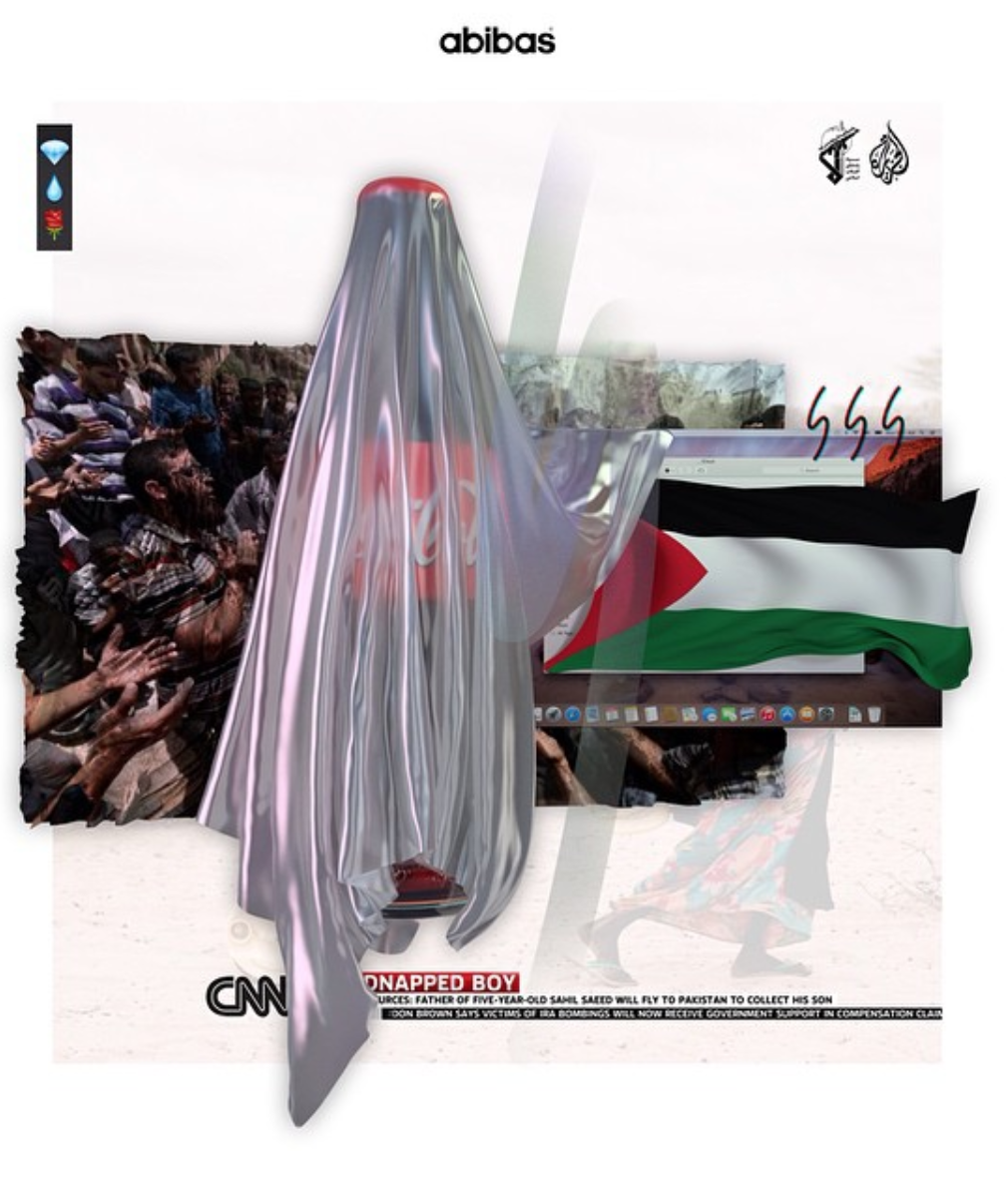
From San perspective people in Slovakia, Philippines, and Denmark, Google “Nike” more than Americans. Katy Perry has more appeal in Mexico and Guatemala, and no concrete statements can be made, such statistics deliver vivid examples of how the US has dominated the world at cultural exportation. “Relatively speaking, US is not even its own best customer,” he says. He believe in Iranian regime referred to this as “west’s cultural invasion” assuming that now it’s unfolding more than ever before. So no matter how much people would like to deny the influence, inevitably it’s there. Mouldable and ever-changing also in a way that it is possible to merge tradition and modernity. “More than anything it’s the manifestation of the medium in the context of the piece. If I was to create with analog tools or even paint or draw exactly what I create using the computer, it could be considered fine art in the traditional sense. The medium is evidently more impermanent than the subject, and it’s in this temporariness that modernity is so fleetingly formed.” Sad says.
Tianzhuo Chen
Another great artists is Tianzhuo Chen born and risen in China, Graduated Bachelor studies in Saint Martins in London and Master in Chelsea Art. Tianzhuo Chen is an artist who’s work is strongly defined by Pop culture what is evident everywhere in Chen’s work. He uses Eric Cartman and Michael Jordan on a rugs, rap music symbols like gold chains and gold teeth underlining in every way his relationship to pop culture. Chen’s work is basically his personal interests and experiences of pop-culture or sub-culture scenes—both in urban China and in the UK. This artist is keen on making work which is reflecting our generation's life, and share the same experience with them. He takes characters from cartoons or pop culture iconography and absorbed them into my new cult symbol system. He creates a tension between pop culture and religion. As an example he used one of Lana Del Rey's songs in his shows and tried to create another interpretation when he uses it into the context of a religious story. When an upside-down crucified figure sings the song, it becomes like a sacrifice. Video artwork which he made for musician artist Aïsha Devi is a colourful, grotesque and kitsch imagery, with domination of drugs, LGBT and hip hop. What else you can see in his art work is strong influence of London rave scene, use of Japanese Butoh dance theatre traditions, voguing in New York and the fashion world, which forge an intimate connection between his works and the collapse of moral attitudes and beliefs we see around us. Mixed paintings, drawings, installations, videos and performances, incorporate religious symbols into iconographic elements borrowed from urban subcultures, which are shared by youth culture globally nowadays. 39 40 41 42 42

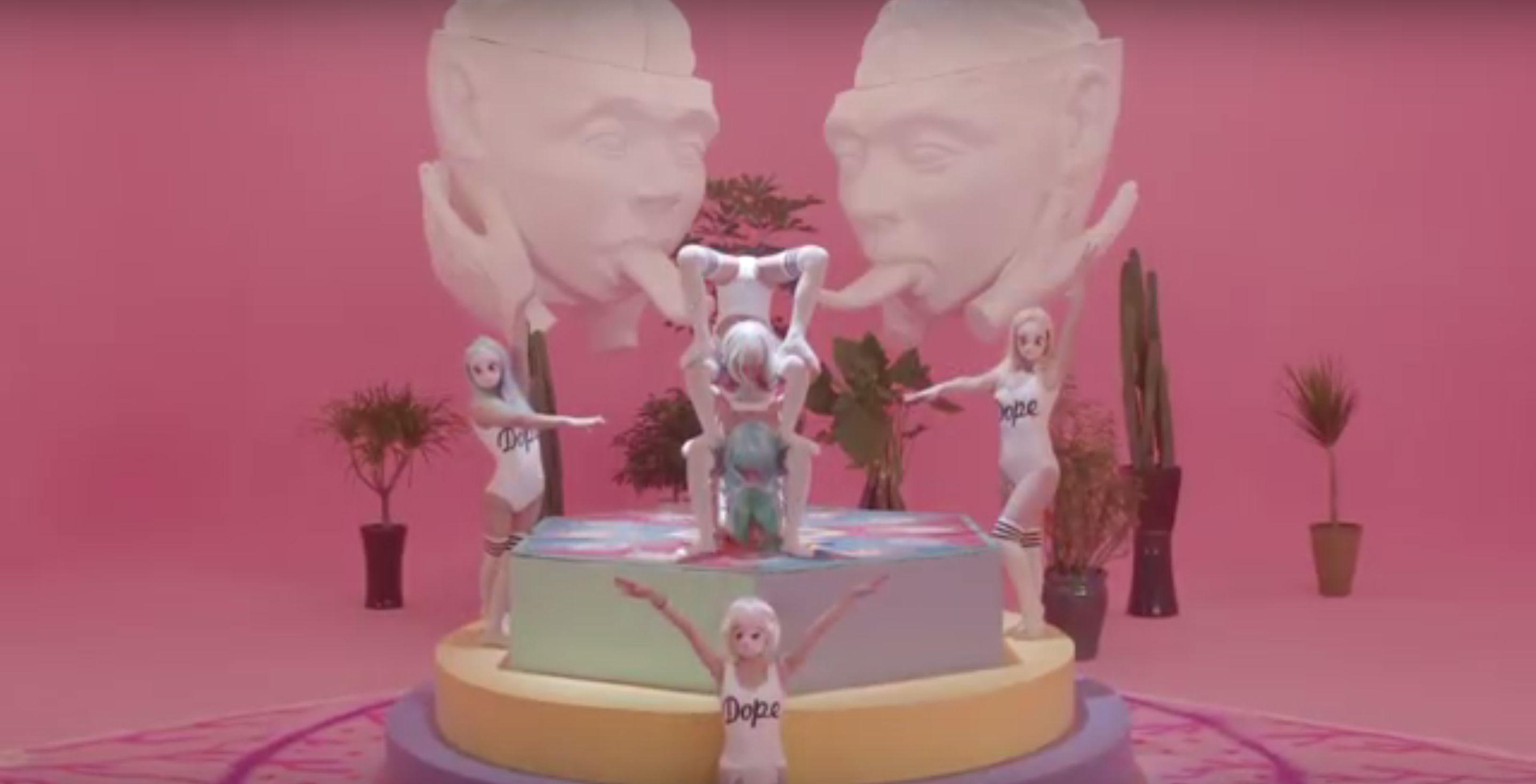
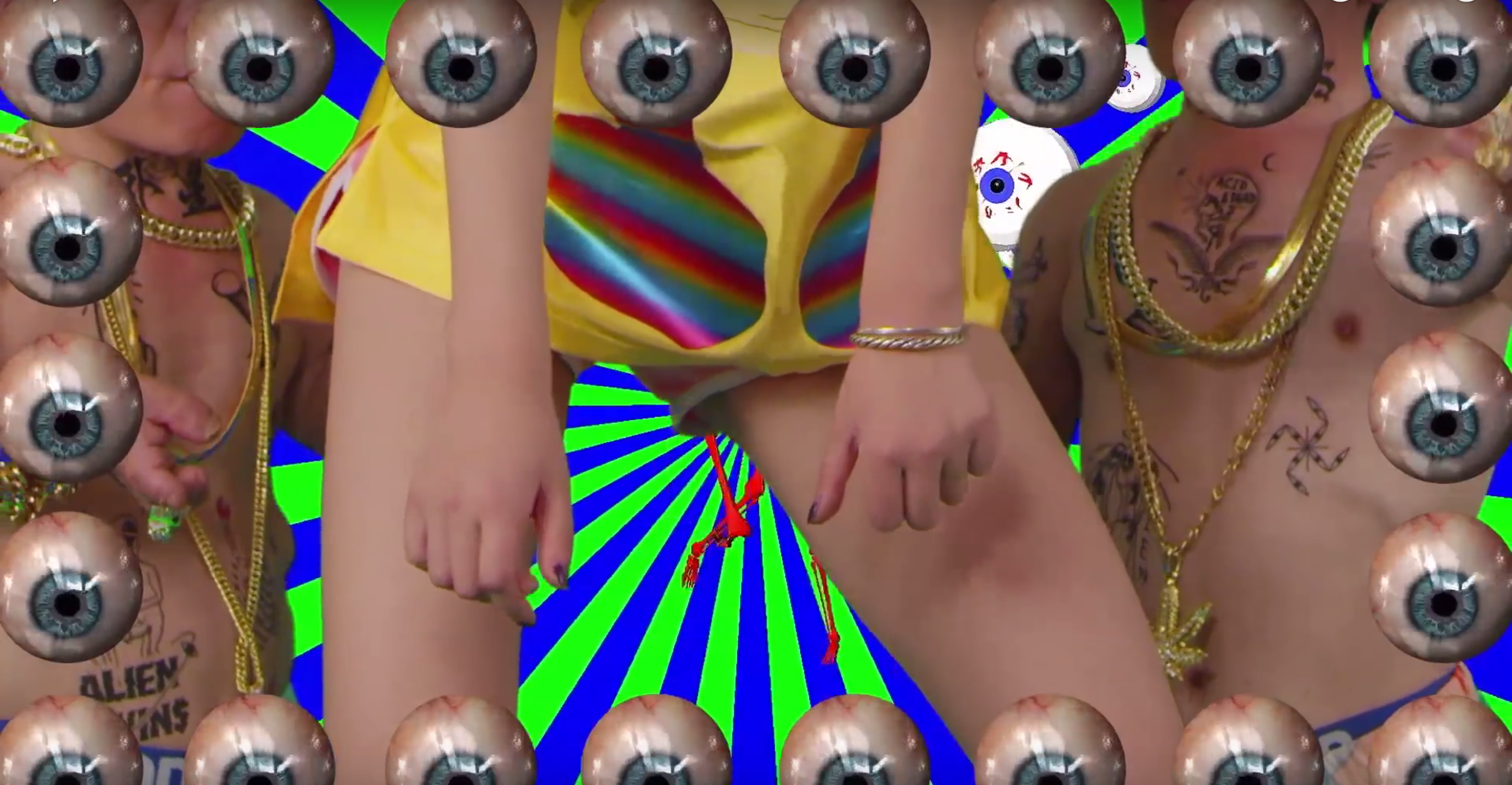
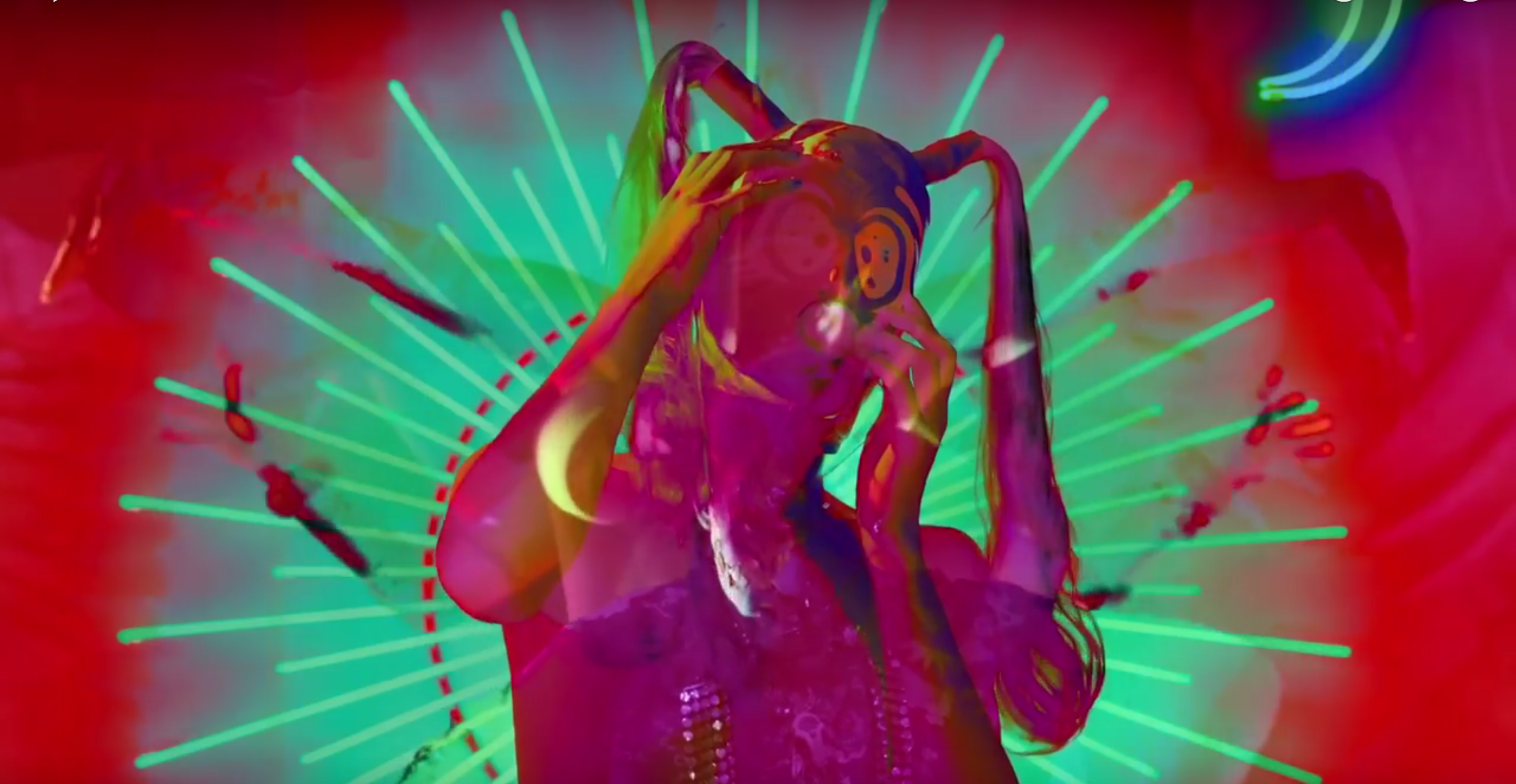
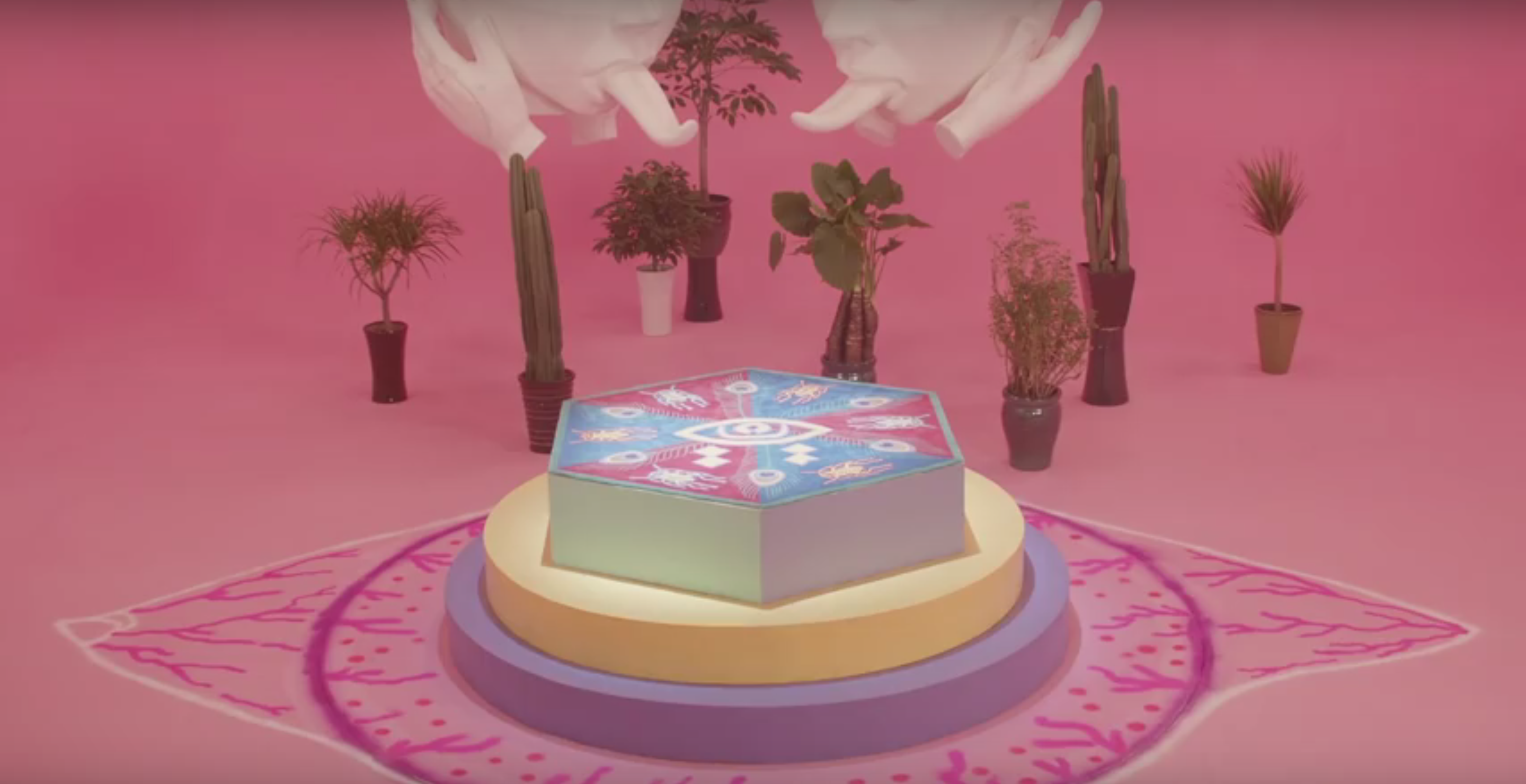
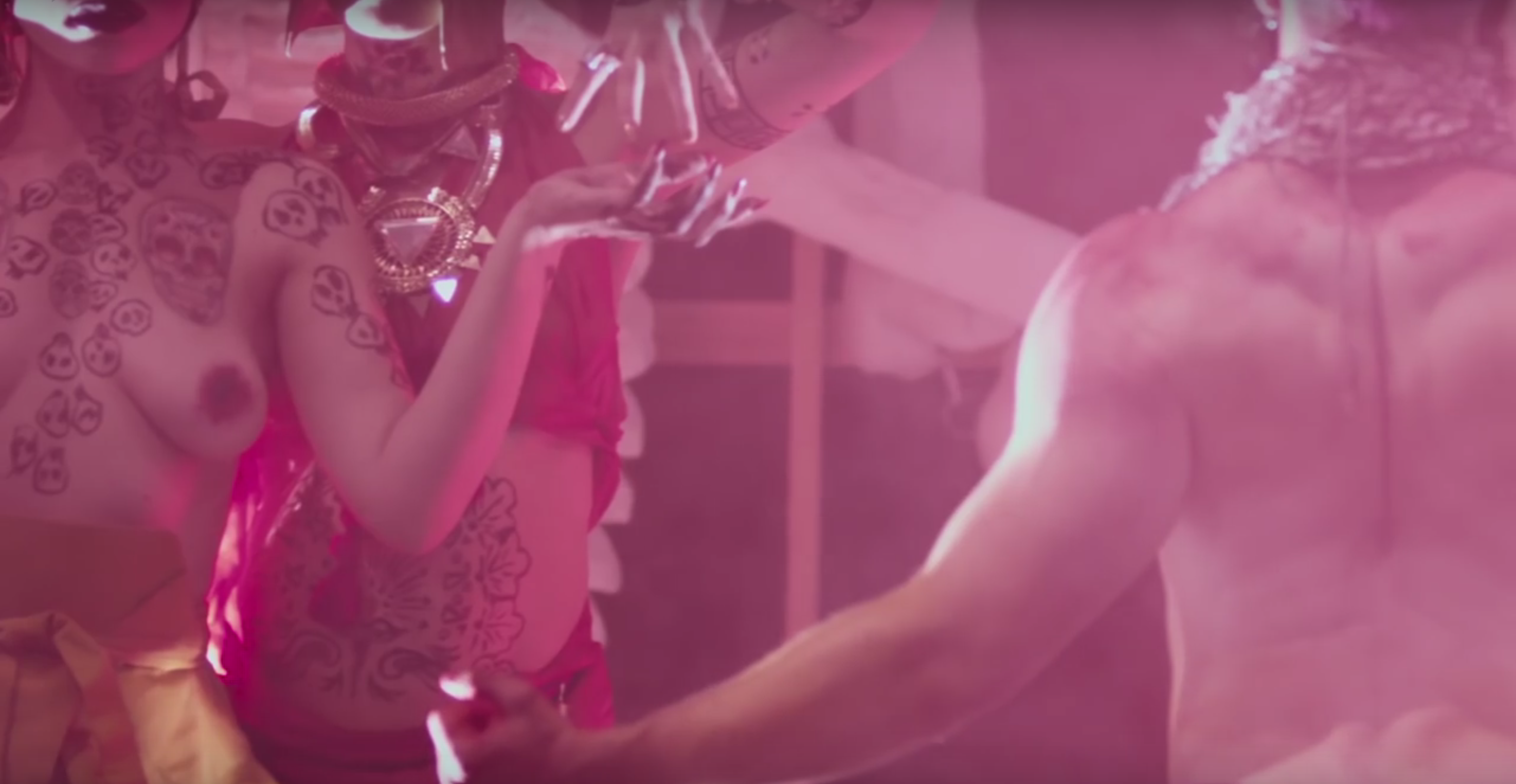

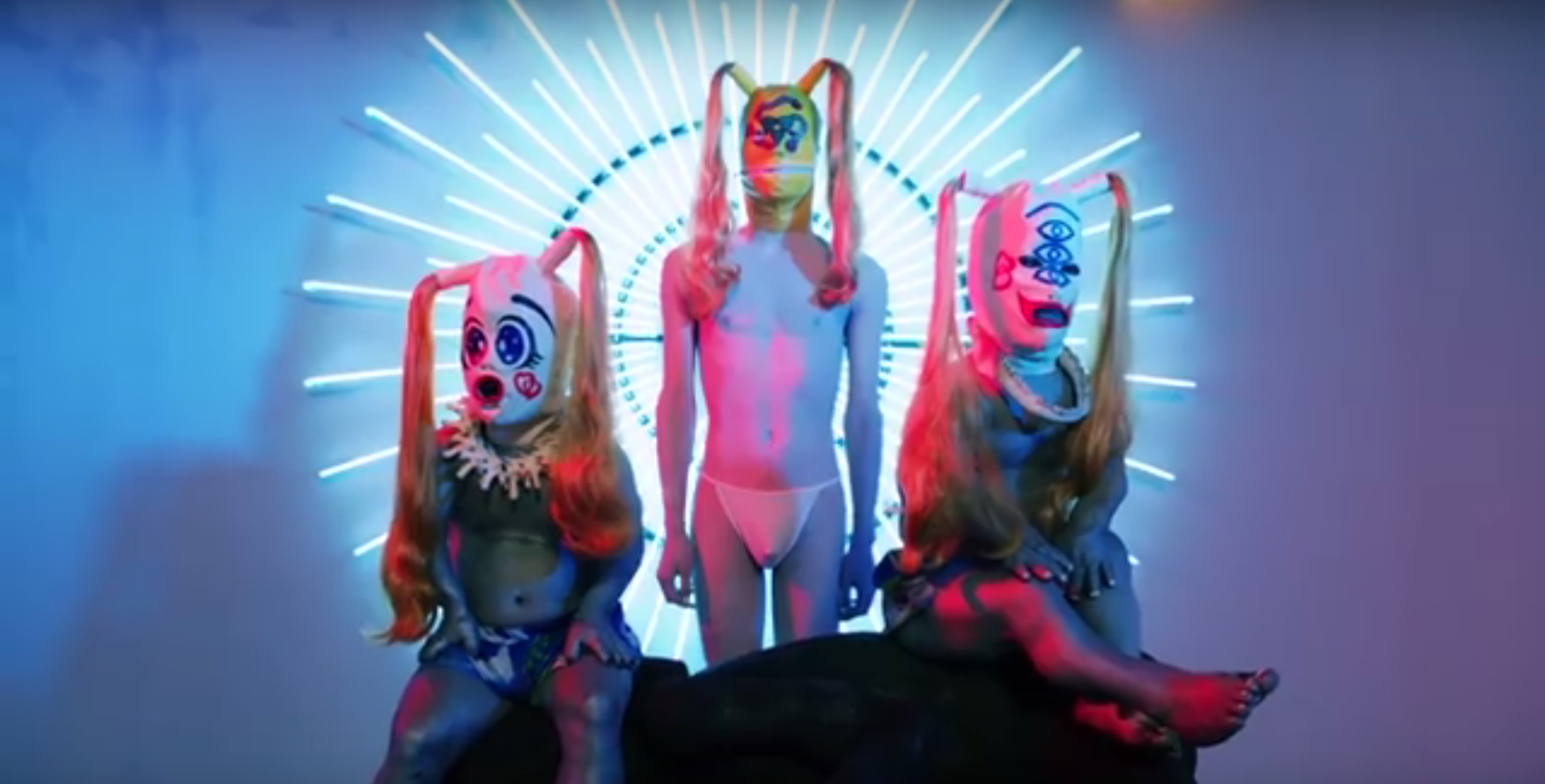
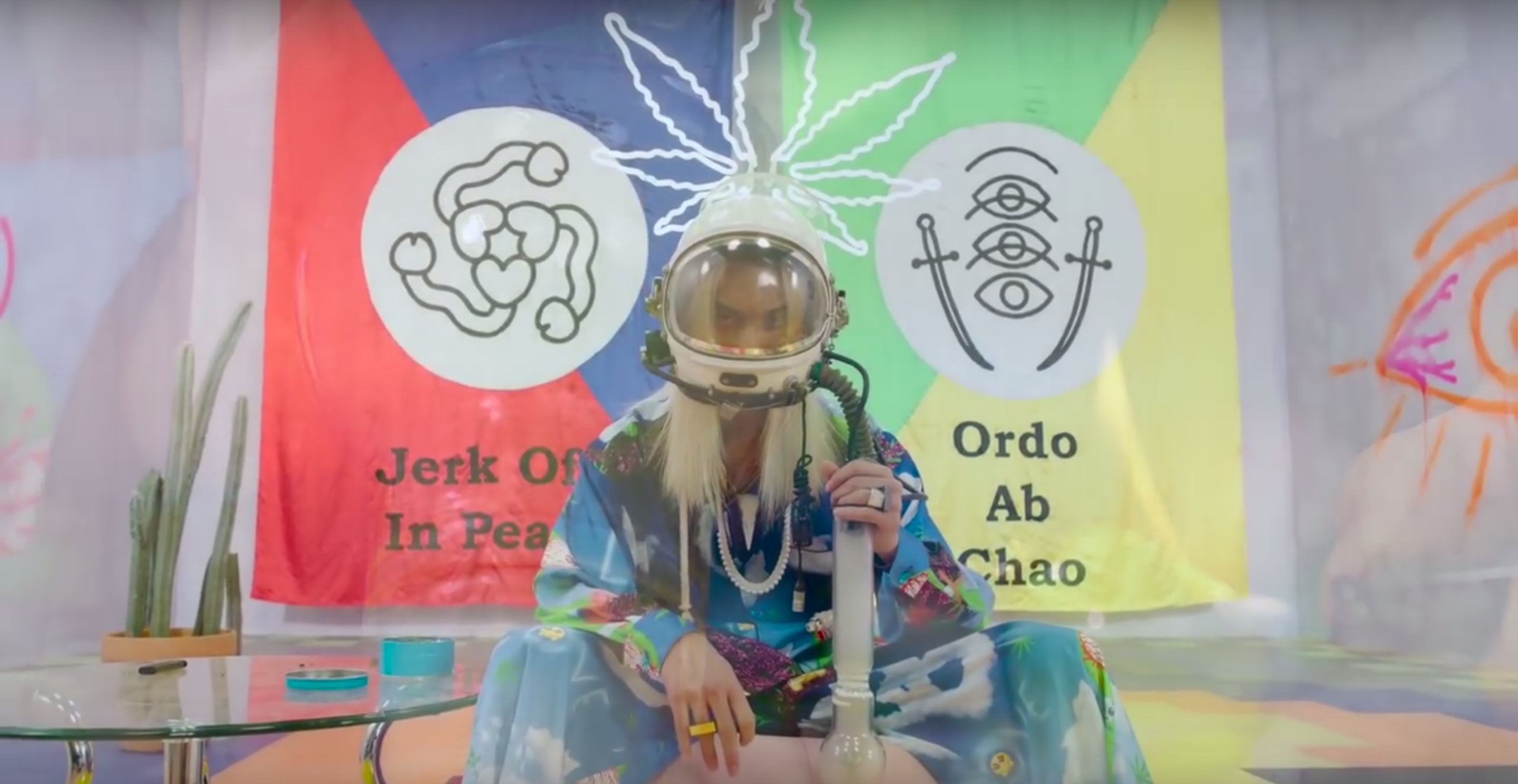
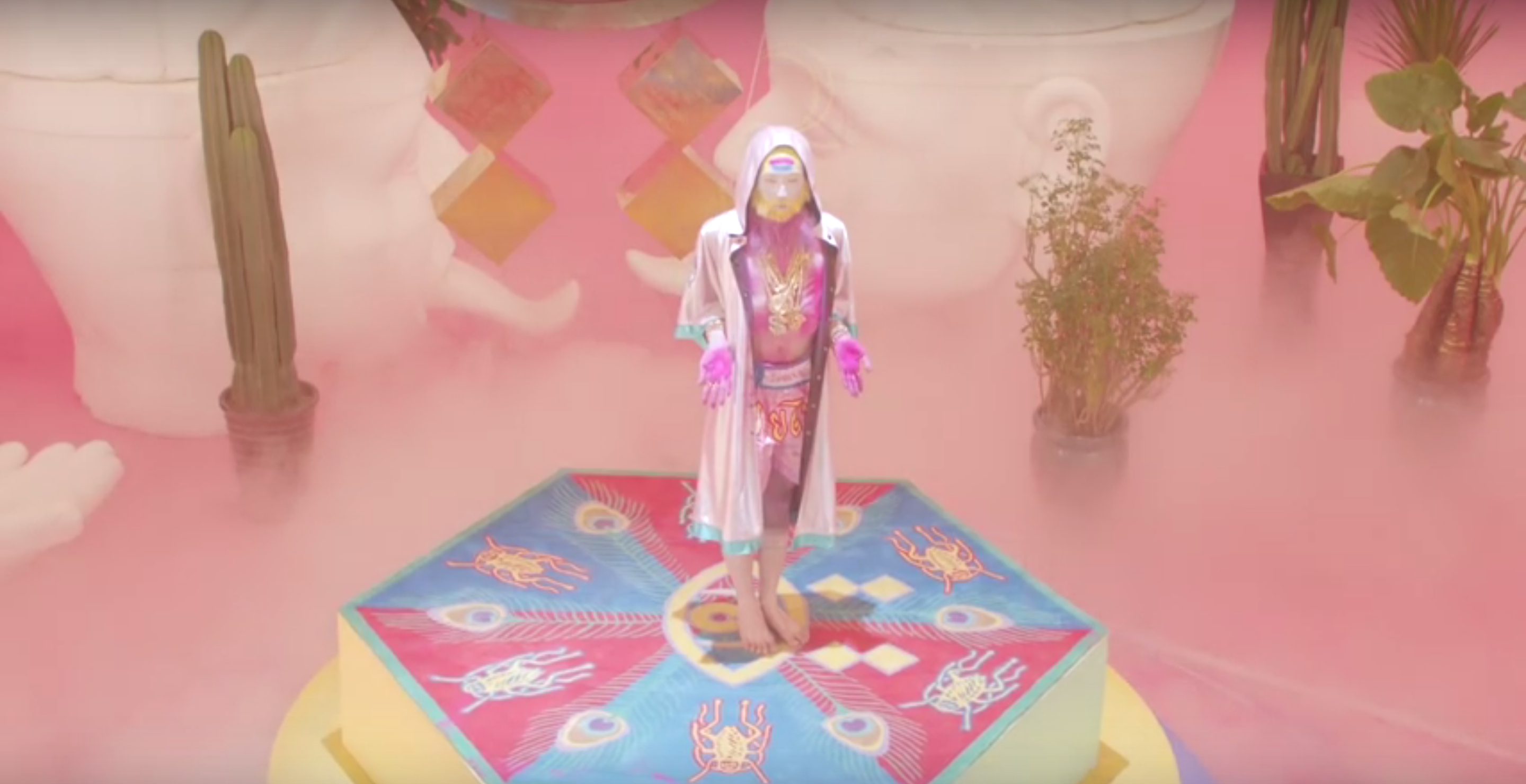
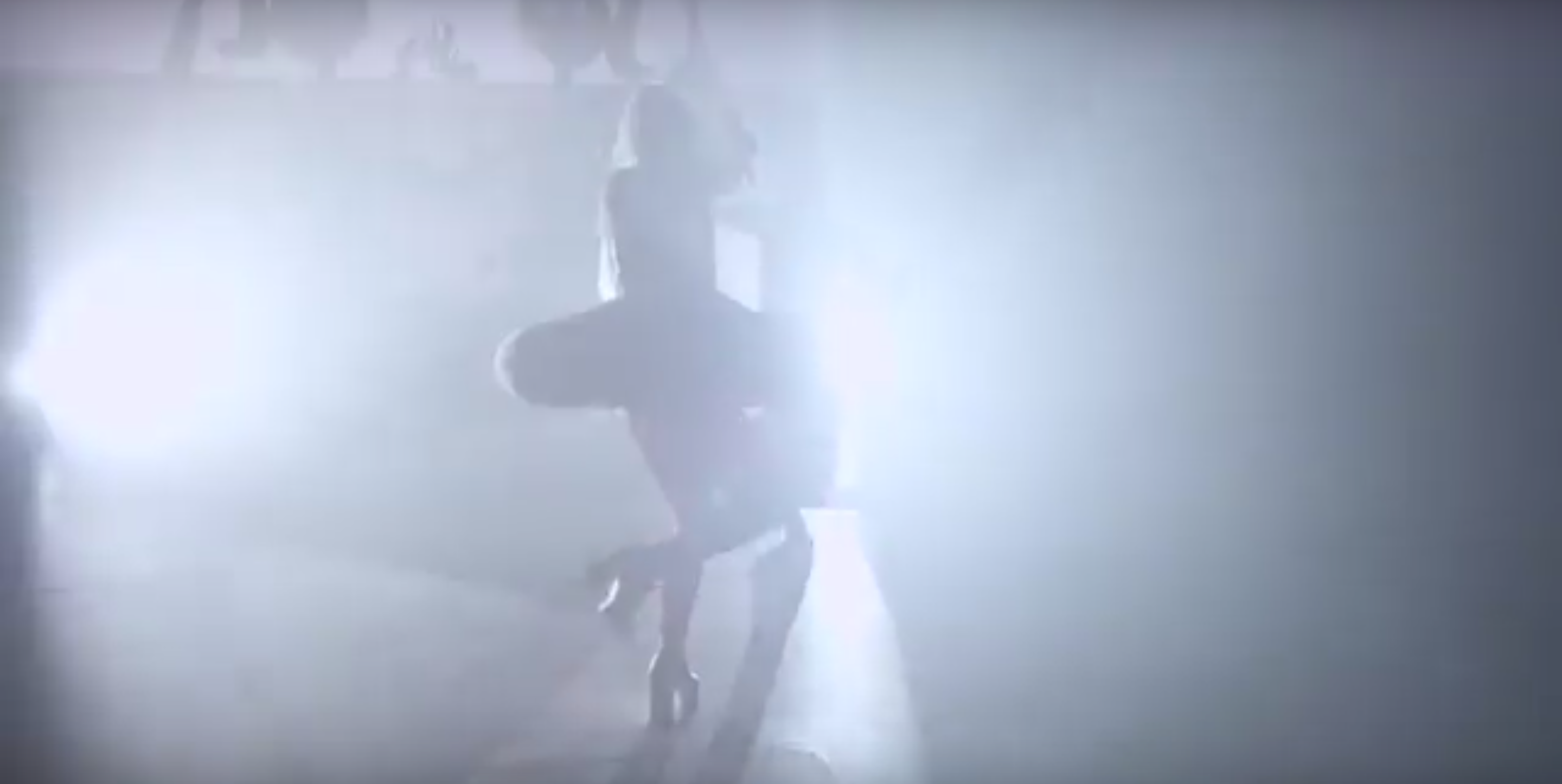
Conclusions
Referring to Ruben Pater’s “The Politics of Design”, creativity can not be disconnected from the values and assumptions in which it was created because every design carries certain ideologies and those are connected with visual communication and every ideology has its own perspective. By coming from different parts of the world people collect burden [bias] knowledge which creates different perspectives on a wide range of topics. While traveling and discovering “unknown” lands, people correct their blind spots of their own perspectives. Different territories contain own visual communication which creates its own visual literacy and a way of understanding and ability of reading it. Comparing it to verbal literacy its something that has to be learned. The amount of images that has been seen builds our experience, and each culture reads images in different ways because of their different perspectives like meaning of used colour, white for example is a colour of death and mourning in China, in religions such as Christian and Hindu white is a colour of purity, chastity, virginity and peace, so this means while transcending territories we get to know new ways of understanding and we discover ourselves at the same time. In my perspective cultural heritage is a great factor that very strongly builds identity of artists because of belonging to different groups which are related to diverse nationalities, ethnicities, religions, generations and territories. I see grand importance and potential in artists traveling process, because of the cultures variety that artists face. In my opinion it brings fantastic input into shaping identity because identity is a constant process mechanism. Metaphorically the Identity is like a tree, where the main roots and core contains one, solid, natural and original piece but everything what is above can be stimulated. By given examples I believe our environment and circumstances like political stability, governmental support, economical sufficient position, general people living standard, mental comfort impacts really strongly on the way how we are creating art. I don’t think staying in one place is healthy for the creativity and innovation of designing process. I think we have to constantly look for new mechanisms which can reshape or redirect our way of thinking and approaching. I think values we had shaped by our parents during the childhood are very important but then while we rise we need people who brings us differences and new possibilities that we can learn from. Cultures used to complex through regions, countries, religious nowadays becoming more diverse.
THE END
